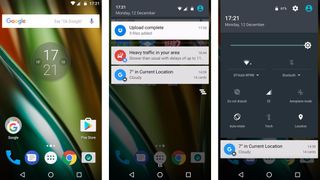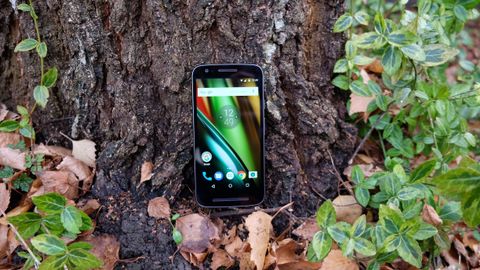Why you can trust TechRadar
Interface and reliability
- Stock Android 6.0
- Typical lack of embellishment from Motorola
The Moto E3 doesn’t run on the very latest version of Google’s Android operating system, but Android 6.0 Marshmallow still feels sufficiently fresh. There are plenty of far more expensive phones that are still shipping with this, so it’s not a negative point by any means.
This is pretty much Android as Google intended, with minimal embellishment. You might happen to like the distinctive changes wrought by Samsung, HTC, Huawei and co, but for our money you can’t beat Motorola’s approach.
Left well alone as it has been here, Android is an intuitive, attractive operating system that has been honed to a sheen over successive versions. It largely gets out of the way of the everyday things you want to do like surfing the internet (only one web browser here), checking your email (ditto) and placing calls.

Stock Android’s notifications remain the best in the business - bettering the way iOS 10 handles them. There’s a clarity of presentation and just the right degree of information for individual notifications here that Apple hasn’t been able to match.
This being Android 6.0, you also get Google Now on Tap through a long press of the virtual home key. This scans whatever’s on your screen and seeks to provide contextual information. For example, using it whilst reading a story on Donald Trump initially gave us a brief description of the man himself. Scrolling to a different part of the same story, however, yielded details on Taiwan.
In truth, the kind of information Now on Tap provides still isn’t quite smart or specific enough to be consistently useful. We suspect you’ll continue to use plain old Google Now far more, which is still accessible through a swipe to the left from the main home screen, and provides a range of personalized cards based on your tastes, emails, browsing and habits.

Indeed, the only clear sign that this is a phone made by a third-party manufacturer is the presence of a circular Motorola time widget placed on the main home screen - which, of course, can be removed with a press, hold and swipe.
In all, the Moto E3 continues the brand’s tradition of no-frills Android, and long may it continue.
One modern feature of Android you won’t be able to exploit with the Moto E3 though is Android Pay. The E3 doesn’t have NFC, which means Google’s mobile payment system is off the cards.
Movies, music and gaming
- Screen makes for a better viewing experience
- Low internal storage, but microSD can be formatted to stand in
It shouldn’t surprise you to learn that the Moto E3 isn’t a particularly accomplished media player. That just isn’t its game, and anyone seeking a phone for extended video or gaming sessions will need to pay double the price or more for that facility.
Still, the Moto E3 is much improved over its predecessor in this regard. The main reason for that is the aforementioned larger and sharper display. At 5 inches and 720p, suddenly YouTube content looks clear and sharp, and you’d actually consider watching an episode of something through the Netflix app.

Provided you have a set of headphones to hand, that is. The Moto E3’s solitary speaker is tinny and lacking in depth - though in its defense, it is at least front-facing. This means you won’t cover it up when you hold the phone in landscape view, as is often the case with phones that mount their speaker on the bottom edge.
Given the Moto E3’s use of stock Android, you get Google’s Play Music app as standard for your streaming and MP3 shopping needs.
If you’re downloading audio files from another source, the File Manager app will serve to play them for you - as it does with video content - but it won’t offer much beyond a small thumbnail of album art. Though of course you can download other players from the Google Play Store.

Gaming on the Moto E3 is reasonably comfortable given the improvements to its display, but as we’ll discuss in the next section, its processor really isn’t up to much heavy lifting. We were able to get Dead Trigger 2 and Reckless Racing 3 to play on low settings, but both suffered from frequent stutters and pauses in the action.
The Moto E3’s media ambitions are also capped by the perilously low amount of internal storage it has. 8GB really isn’t a lot at all, especially when a large chunk of that is taken up by Android itself.
On the plus side, the Moto E3 has a microSD card slot, and Android 6.0 has a facility to format a card (up to 32GB) to act as internal storage. Access won’t be as speedy as with internal storage, though.
Specs and benchmark performance
- MediaTek MT6735P isn’t a strong performer
- 1GB of RAM seems insufficient
You wouldn’t expect anything like top-notch performance from the Moto E3, but we have come to demand a base level of consistency and competency from our affordable phones. Unfortunately, this is one area where the E3 noticeably suffers.
It runs on a MediaTek MT6735P chipset, which is a decidedly low-end quad-core 1GHz SoC, and this is paired with 1GB of RAM. This setup doesn’t seem to be quite enough for anything.

Simply navigating through the E3’s home screens is far from fluid, while apps and web pages take ages to boot up. Meanwhile, as we discussed in the previous section, gaming performance is far from satisfactory.
This unimpressive performance feeds through to the popular Geekbench 4 benchmark test, where an average multi-core score of 1200 places the Moto E3 in the same kind of territory as the ZTE Blade V7 Lite (1164) and way behind slightly pricier but still budget phones like the Bush Spira E3X (2891) and Wileyfox Swift 2 Plus (2073).

Is it churlish to complain about such performance issues in a sub-$150/£100/AU$200 phone, or compare it against more expensive phones? Perhaps. But when the next tier up of smartphone can provide a fluid experience for everyday tasks, and even a competent experience for demanding tasks, it makes you wonder.
Is the ultra-affordable smartphone tier the last bastion of downright poor performance? Have we come to expect a certain level of fluidity from our phones? The success of the Moto G4 and its legions of rivals immediately above the E3 suggests that might be so.
The point stands that if you can stretch to $200/£150/AU$300 or more, the potential improvement in all-round performance is massive.
Current page: What's it like to use?
Prev Page Introduction, key features and design Next Page Battery life and camera
